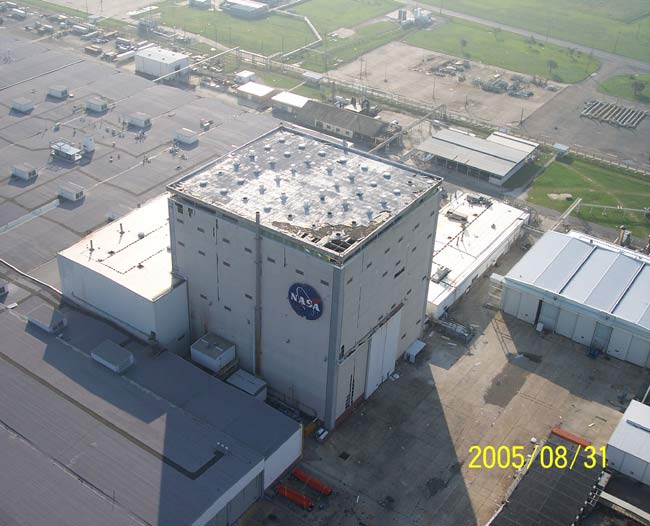NASA Facility Struggles in Wake of Hurricane Katrina

NASA's Michoud Assembly Facility in New Orleans, where space shuttle external tanks are constructed, appears to have escaped major damage from Hurricane Katrina.
But unknown is just how many employees at the site--operated by Lockheed Martin Space Systems for NASA--are missing, evacuated from the area, and are now without housing.
The Lockheed Martin company's main Internet site is now reformatted, headlined with response information for the firm's employees affected by Hurricane Katrina. It carrys a hotline number that operates from 8:00 a.m. to 7:00 p.m. Eastern time. A message posted on the website said there were "no injuries reported" but the company was "still confirming status of some employees. The facility will re-open no earlier than Monday, September 26."
The site calls out: "Let Us Know If You're OK ... If you are a Lockheed Martin employee affected by Hurricane Katrina, we'd like to know you're OK."
The site requests company workers to call the hotline or send an email listing their name, business unit, a phone number, and an address where that individual can be reached. It also says that several locations with Lockheed Martin employees were affected by the hurricane.
Operators at a Lockheed Martin Hurricane Katrina Employee Assistance Hotline are assisting in answering employee questions, or guiding them to the appropriate resources for assistance.
Workforce disruption
Get the Space.com Newsletter
Breaking space news, the latest updates on rocket launches, skywatching events and more!
Harry Wadsworth, a Lockheed Martin spokesman for Michoud operations, said an emergency team at the external tank facility has been clearing debris.
"Ours is a fairly open area with buildings. There are not a lot of trees, which is probably good," Wadsworth told SPACE.com in a phone interview. He is positioned some three hours away from Michoud at this time, in Lafayette, Louisiana.
Like many others that work at the Michoud facilities, Wadsworth also has no idea whether or not his own home survived the horrific blow to the area created by Hurricane Katrina.
"I'm hoping that my house is dry. I would be lucky if it is," Wadsworth said. His wife is a nurse at one of the local hospitals, part of an essential team that has been in the New Orleans area since Monday.
"People are scattered all over in various cities...places where they took refuge from the storm with their families," Wadsworth said.
Regarding the disruption of the workforce at the facility, Wadsworth said that this remains an unknown.
"It will be one of the challenges...to get employees temporary housing, apartments," or other types of shelter, Wadsworth added. "That's something that a lot of the companies in New Orleans are looking into."
Water, power issues
The Lockheed Martin workforce is between 2,000 and 2,100 employees at the NASA Michoud Assembly Facility, Wadsworth said.
Wadsworth said that it is doubtful very many people have been able to get back and check on their homes, although some areas are open. For those able to return to the hard hit area at this time, they face no water availability, power, nor air conditioning to combat the 98-degree outside temperature, he said.
The 832-acre NASA Michoud Assembly Facility is located in New Orleans, Louisiana some 24 miles (38 kilometers) from New Orleans International Airport and 15 miles (24 kilometers) from the French Quarter.
The Michoud facility uses a deep-water access port for the transportation of the large external tanks by barge across the Gulf of Mexico, around Florida and up to Kennedy Space Center.
Lockheed Martin's toll-free Hurricane Katrina Employee Assistance Hotline for employees is at (800) 563-8442 from 8 a.m. to 7 p.m. EDT, Monday through Friday.
Join our Space Forums to keep talking space on the latest missions, night sky and more! And if you have a news tip, correction or comment, let us know at: community@space.com.

Leonard David is an award-winning space journalist who has been reporting on space activities for more than 50 years. Currently writing as Space.com's Space Insider Columnist among his other projects, Leonard has authored numerous books on space exploration, Mars missions and more, with his latest being "Moon Rush: The New Space Race" published in 2019 by National Geographic. He also wrote "Mars: Our Future on the Red Planet" released in 2016 by National Geographic. Leonard has served as a correspondent for SpaceNews, Scientific American and Aerospace America for the AIAA. He has received many awards, including the first Ordway Award for Sustained Excellence in Spaceflight History in 2015 at the AAS Wernher von Braun Memorial Symposium. You can find out Leonard's latest project at his website and on Twitter.











